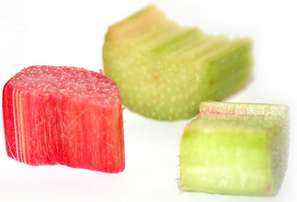Last updated on June 17th, 2023 at 12:19 am
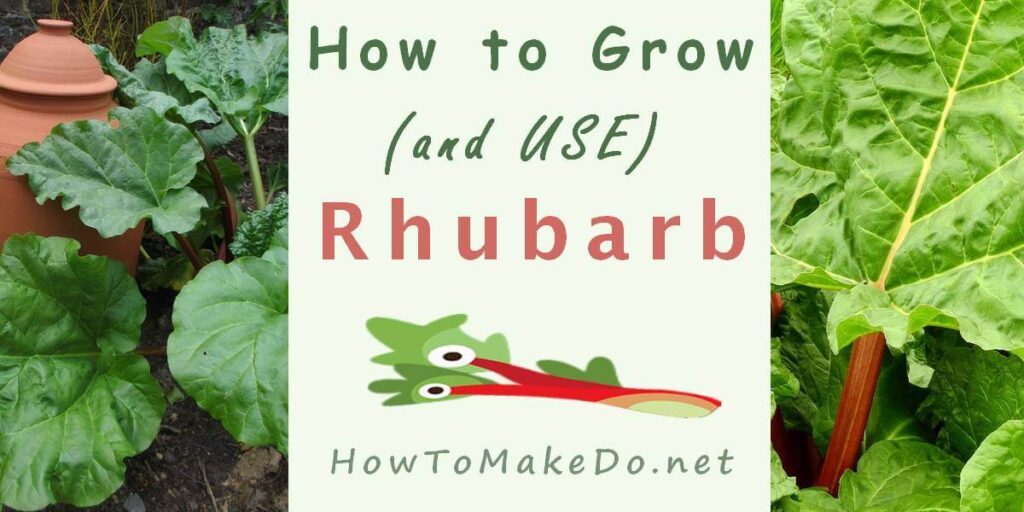
How to plant, grow, divide and use rhubarb, with delicious rhubarb recipes.
by Jane Lake

Rhubarb is a perennial vegetable that is most often used like a fruit. That’s because rhubarb is delicious in jams, pies, crumbles, sauces and condiments.
Rhubarb grows well in most gardens and a half-dozen plants will produce enough rhubarb for four people.
Recommended rhubarb varieties include Canada Red, with long, thick, extra sweet stalks; Cherry Red, which is a rich red color inside and out; Crimson Red, with tall, plump petioles; MacDonald, known for its brilliant red color and tender skin; Valentine, a good flavored rhubarb, and Victoria, which is shaded with red.
How to Plant Rhubarb
The University of Illionois extension offers these rhubarb planting tips:
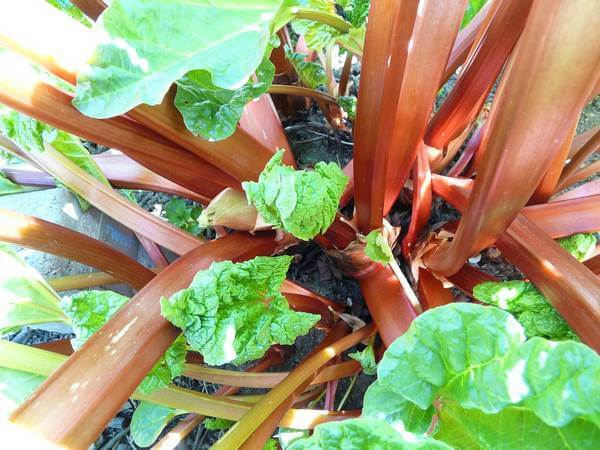
- Growing from seed is not recommended, largely because dividing rhubarb is quicker and easier. (You can read more on dividing rhubarb in just a moment.)
- Plant the roots with the crown bud 2 inches below the surface of the soil.
- Space the roots 36 to 48 inches apart in rows 3 to 4 feet apart.
- Good garden drainage is essential in growing rhubarb. Planting on raised beds protects against rotting of the crown.
- Working lots of well-rotted manure or compost into the rhubarb bed before planting greatly increases production.
How to Grow Rhubarb
Once established, rhubarb is an easy keeper. Use these seasonal tips to care for your rhubarb patch:
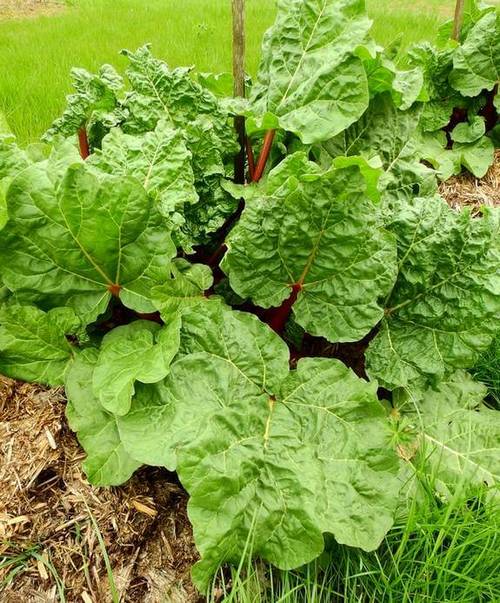
- Apply manure or compost in late fall or early winter, taking care not to cover the crowns.
- In Spring, before leaves emerge, apply a complete garden fertilizer followed by a side dressing of high-nitrogen fertilizer three months later.
- Organic mulch is beneficial to help retain moisture. Water new plantings until established; older plants should only need watering during extended dry periods.
When and How to Divide Rhubard
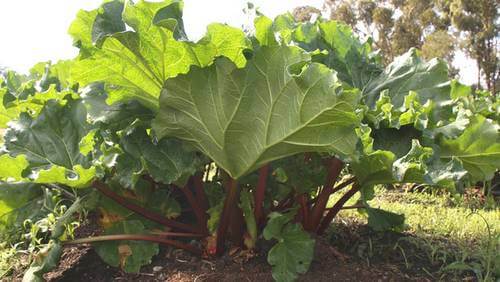
To improve vigor and leaf size, many gardeners divide old rhubarb plants and establish a new planting after at least 5 years of full harvest. Plantings older than this tend to begin crowding themselves out.
Old roots may be dug and divided to make new plantings. Cut the roots into four to eight pieces. Each piece must have at least one strong bud.
Dig the roots of the most vigorous, healthy plants to establish a new bed the spring before the old planting is to be discarded.
How to Harvest Rhubarb
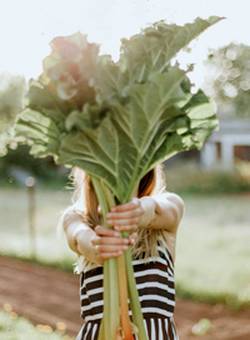
TO HARVEST RHUBARB: Pull the stalks from the plant, rather than cutting. A slight pull and a twist at the base of the stalk should release it quite easily. Trim off the leaves, which are poisonous and should never be eaten.
- FIRST YEAR: First year rhubarb should not be harvested. Allowing the foliage full growth during this time helps build a strong root system.
- SECOND YEAR: Second year rhubarb can be harvested for two weeks with the harvest extended for 8 to 10 weeks in subsequent years.
- Remove only one-third of the stalks at any one time to keep the plant vigorous and healthy.
- If seed stalks develop, cut them from the rhubarb plant as soon as they appear and discard.
- Yield and quality are at the highest when you harvest stalks that have just reached full size but before stringy fibers have a chance to develop. As a general rule, flavor is enhanced in stalks with deep red color.
Storing and Using Rhubarb
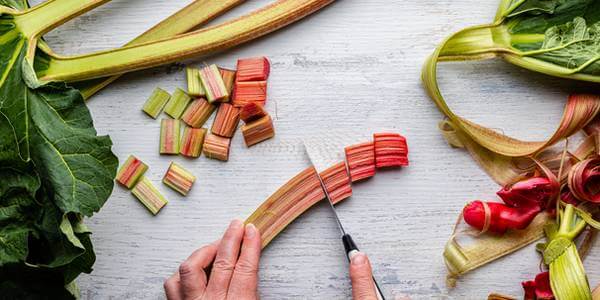
FRIDGE: Trim and discard the rhubarb leaves. Tightly wrap the fresh, unwashed stalks in plastic and keep in the refrigerator for up to three weeks.
FREEZER: To freeze, wash the stalks, remove any tough outside fibers, chop into 1/2 inch to one inch chunks and spread on a cookie sheet to freeze. Once frozen, seal tightly in plastic freezer bags or freezer containers. Frozen rhubarb will keep for up to six months and can be used in place of fresh in most rhubarb recipes. To prepare rhubarb for cooking, remove any brown or scaly spots or stringy fibers. Peeling is not required; simply trim off each end of the stalk, then wash and dry.
COOKWARE: Cook rhubarb in non-reactive cookware such as anodized aluminium, stainless steel, teflon or enamel. Do not use pots made of aluminium, iron or copper as both the fruit and the pan will darken.
Rhubarb is very sour and requires the addition of a sweetener in most recipes.
Rhubarb Nutritional Information and Benefits
NUTRITIONAL PROFILE: One cup of rhubarb provides 26 calories, 2 grams of fiber, 1 gram of protein, 6 grams of carbohydrates, 10 mg of vitamin C, 8.7 mcg of folic acid, 122 IU of vitamin A, 105 mg of calcium and 351 mg of potassium.POTENTIAL BENEFITS OF EATING RHUBARB:
- Rhubarb is low in calories and fat while being a good source of dietary fiber, vitamins, and minerals
- Rhubarb is rich in antioxidants, particularly anthocyanins and polyphenols. Antioxidants help protect your body against oxidative stress and damage caused by harmful free radicals.
- The fiber content in rhubarb promotes healthy digestion and helps prevent constipation.
- May help with weight loss. Rhubarb is a filling food choice. Consuming foods with high water and fiber content, like rhubarb, helps you feel fuller and may assist in managing or losing weight.
- Some studies suggest certain compounds in rhubarb, such as polyphenols, may possess anti-inflammatory properties. Chronic inflammation excaberates various health conditions, so consuming foods with anti-inflammatory properties can potentially be beneficial.
- Rhubarb contains potassium, essential for maintaining heart health. Potassium helps regulate blood pressure and can contribute to a healthy cardiovascular system when consumed as part of a balanced diet.
Rhubarb Rumba: Delicious Ways to Dance with a Vegetable

Here’s where we party with rhubarb!
Rhubarb is so versatile, in so many ways, how can you resist? Having established, or inherited a rhubarb patch, you might want to try some these delicious ways to use your rhubarb harvest.
The following article by rhubarb fan, Captain Anne Mahle, includes a round-up of planting and using rhubarb.
This is followed by tried-and-true rhubarb recipes:
- Rhubarb Jam and Rhubarb Currant Chutney.
- Rhubarb Sauce (a cut above stewed rhubarb)
- Crunchy Sugar Rhubarb Muffins
For the Love of Rhubarb
Memories of Rhubarb:
I have great memories of the rhubarb that grew near my early childhood home on the backside of the garage. It was the sunniest part of the yard and that’s why it was located there, but it was hidden from the rest of the house and it always felt a little bit enchanting back there. The warnings about the leaves being poisonous made it a little bit forbidden as well and although I never used the leaves for food, I used to love to suck on the stalks. The leaves were relegated to doll blankets, elf hats, skirts, fairy boats and other useful items.
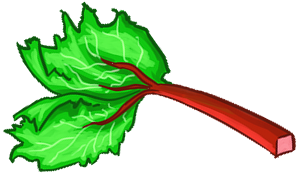
Rhubarb is one of the first vegetables (yes, it is a veggie) that I grew when I was a beginning gardener. It’s so forgiving that it’s a snap to grow. It comes back faithfully every year, is relatively disease free, needs little dividing or attention and produces a wonderful harvest.
While rhubarb is relatively maintenance free, I have learned after many years, that there are a few things that will help your rhubarb thrive. The stalks are actually pulled out when harvested, not cut. I usually end up cutting the leaves off right then and leaving them as mulch around the base. If I’m feeling extra energetic they go in the compost pile. When you harvest, you want the longest and biggest stalks, but only take 1/3 of the plant at a time or you will decrease its vitality over time. Rhubarb does well with a heavy feeding of compost in the spring or fall and it’s best to break off the seedpods before they go to seed.
Once harvested, it will last, covered, in the refrigerator for several days. It freezes well, and after I’ve had my fill of pie and the rest, I cut it into 1-inch pieces and freeze it immediately. I can then scoop out what I need over the course of the next few months.
About The Author: Anne Mahle is a captain and chef and spends her summers cooking for guests on the Maine Windjammer, Schooner J. & E. Riggin, which she co-owns with her husband.
Rhubard Recipes
Rhubarb Currant Chutney
1/3 cup sugar
1 1/2 tablespoons cider vinegar
1 1/2 teaspoons minced ginger
1 1/2 teaspoons minced garlic, or 1 clove
1/4 cup minced onion
1/2 teaspoon cumin
1/4 teaspoon ground cinnamon
1/4 teaspoon ground cloves
2 cups rhubarb cut into 1/2-inch pieces or smaller (about 3/4 pounds)
1/3 cup currents
Add the first eight ingredients to a small saucepan. Bring to a simmer over low heat until the sugar has dissolved, stirring occasionally. Add the rhubarb and the currents and cook over medium-high heat until the rhubarb and onions are soft. Serve warm or cold.
Makes 1 cup to serve 4-6
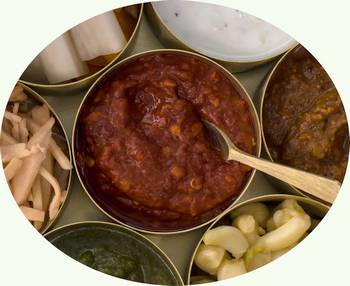
This recipe pairs well with pork tenderloin.
It is easily doubled or tripled and freezes well if you are lucky enough to have a large patch of rhubarb in your yard.
Rhubarb Sauce
4 cups diced rhubarb, cut into 1/2-inch pieces
1/2 cup sugar
1/4 teaspoon cinnamon (to taste)
1/2 cup maple syrup (to taste)
In a medium pot, cook rhubarb, sugar and cinnamon on medium heat for 15 minutes or until rhubarb breaks down. Add maple syrup to taste. Makes about 2 cups.
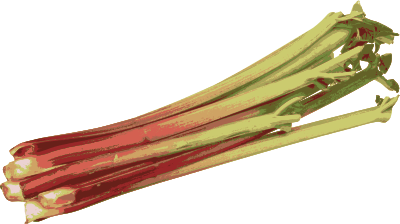
Crunchy Sugar Rhubarb Muffins
2 cups all-purpose flour
1 cup sugar
1 tablespoon baking powder; 3/4 teaspoon salt
1/3 cup vegetable oil
3 large eggs, beaten
1/2 cup milk
1 cup rhubarb, cut into 1/2 inch pieces
1/2 cup large grained sugar like Demerara (optional)
Preheat oven to 350°. Grease muffin pans or line with muffin papers. Sift together dry ingredients. Add oil, egg, and milk. Stir until just mixed. Fold in rhubarb; fill muffin cups two-thirds full. Top with sugar. Bake for 20 minutes or muffins spring back when lightly pressed. Let cool for 5 minutes. Makes 10-12 muffins.
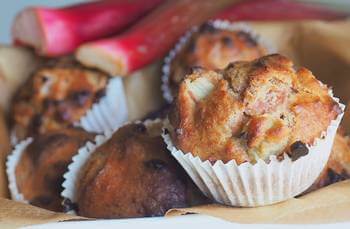
Rhubarb Jam
4 cups diced rhubarb, cut into 1/2-inch pieces
2 cups sugar
1/4 teaspoon freshly grated nutmeg (optional)
Combine all ingredients in a medium stockpot and bring to a boil over medium-high heat. Reduce heat to a simmer, stirring often, until the mixture reads 220° on a candy thermometer.
Transfer to sterilized jars and seal. Refrigerate for up to 2 months or freeze for up to 6 months.
Makes 2 cups
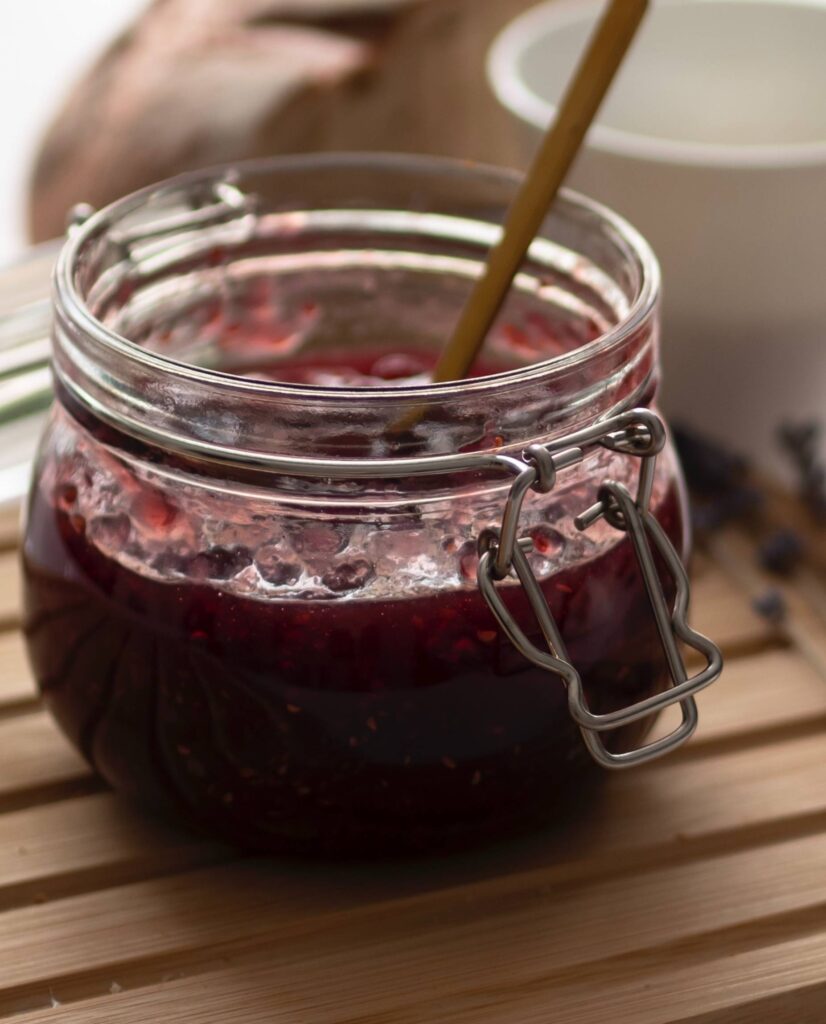
More Rhubarb Recipes
Rhubarb Sauce and Four Ways to Use It from teaspoonofspice.com.
Top Ten Rhubarb Recipes from tasteofhome.com (Rhubarb Custard Bars, Rhubarb Crisp, Strawberry Rhubarb Jam, Rhubarb Scones, Strawberry Rhubarb Cream), Raspberry Rhubarb Slab Pie, Nut-Topped Strawberry Rhubarb Muffins and Rhubarbeque).
